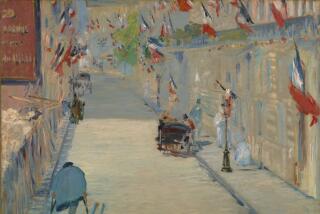ART REVIEW : EUROPEAN EYE FOR U.S. MASTERS
- Share via
SAN DIEGO — Americans have collected European art for several centuries, but Europeans collecting American art? Well, that’s a fairly recent development. Word of a profound change in attitude became widespread a decade or so ago when we learned that German chocolate magnate Peter Ludwig had bought vast quantities of Pop art and that Italian Count Giuseppe Panza di Biumo had amassed Abstract Expressionist paintings during his visits to New York and moved on to acquire light and space works by Southern Californians.
Since then, European interest in American art has moved both forward and backward, dipping into historical eras once discounted by connoisseurs on both sides of the Atlantic. And the exchange has taken on amusing twists, as when “A Day in the Country,” a show of French Impressionism organized in America, traveled to Paris in March and was hailed there as an American triumph.
The latest evidence of this transcontinental art shuffle has arrived at the San Diego Museum of Art in a sweeping survey called “American Masters: The Thyssen-Bornemisza Collection.” The exhibition of 115 paintings, from John S. Copley’s 18th-Century portraiture to Richard Estes’ Photo-Realism, represents about half the American pictures belonging to Baron Hans Heinrich Thyssen-Bornemisza, 64, an industrialist who lives and maintains a museum of Old Master art in Lugano, Switzerland. (American art accounts for about one-sixth of his art collection.)
“American Masters” is not a perfectly complete view of our painting history. It’s overweighted with Luminist landscapes and rather shy on modern works (partly because some pieces are on the road in a separate exhibition of Thyssen’s modern art), but it’s a beautiful, high quality presentation. Certainly fine enough to soothe closet chauvinists and to prove that Thyssen, who told The Times that he makes his own decisions about purchases, knows what he’s doing.
Beginning 12 years ago, he approached American art from the 20th Century backward, first making the link between European and American Modernists by acquiring Charles Sheeler’s 1951 Precisionist painting, “Canyons,” and Max Weber’s 1915 Cubist abstraction, “Grand Central Terminal.” Barbara Novak’s writings on Luminism led him back to 19th-Century landscape and he continues to be fascinated with what he calls “the idea of unspoiled nature.”
Thyssen was just ahead of the crowd in his interest in 19th-Century American work and, in some cases, he had his choice of whole collections that came on the market. Overall, he has bought broadly and wisely, assembling a panorama that touches on a wide range of developments in American art history. The exhibition is installed with a capsule survey in the center and pockets of pictures concentrating on still life, landscape, portraiture and genre in four adjacent galleries. The central view begins with Copley’s dignified portrait of a gray wigged, splendidly garbed magistrate, “Judge Martin Howard” and ends with two pointed reminders of urban mechanization and dehumanization: Richard Lindner’s painting of an outsized robotic couple, mindlessly striding in opposite directions, and Estes’ meticulous “Hotel Lucerne,” a Photo-Realist depiction of a nearly deserted urban street corner. The kindly wisdom of the judge, in the intimacy of his chambers, has been replaced in Lindner’s painting by urban efficiency and in Estes’ work by the chilly silence of life inside high rises.
Between these extremes lie 200 years and an aesthetic revolution. The innocence of Charles W. Peale’s awkward depiction of the regally dressed “Stewart Children” (gathering fruit in the clearing of a miniature forest) is supplanted by the virtuosity of artists smitten with the vast glories of nature. Thomas Cole charges the land with mystical drama, illuminating craggy grottoes with heavenly light and raising a cross that symbolizes the world’s savior. Golden-tinged landscapes by Frederic Church, Albert Bierstadt and Jasper Cropsey make America an enchanted place inhabited by tiny figures, dumbstruck and overwhelmed by its beauty.
Winslow Homer had a somewhat darker view but the romance of the sea pervades his masterful “Signal of Distress” as seamen prepare to send a lifeboat on a rescue mission. Edward Hopper’s “The Martha McKean Wellfleet,” depicting a sailboat and gulls on a bright blue day, is as solidly modeled and hopeful a picture as ever he painted.
At least half the works shown are landscapes, reflecting Thyssen’s preference, and they embrace everything from pristine naturalism to emotional abstraction. There’s a radiant jewel of an abstraction by Arthur Dove, called “U.S. 1940,” several strong Georgia O’Keeffes and the best works by Charles Burchfield I’ve seen anywhere. His “Cicada Woods” and “Orion in Winter” paintings quiver with life but never lapse into the maudlin cartooning that can relegate Burchfield to the storeroom.
Thyssen’s more limited selection of still lifes encompasses William Harnett’s dazzling trompe l’oeil work and fresh flower studies by Charles Demuth. The portrait gallery displays John Singer Sargent’s elegant lifesize likeness of a duchess and a little gem of a picture by Homer, depicting a young woman in black slumped in introspection. Genre scenes run from Romare Bearden’s collage, “Sunday After Sermon,” to Reginald Marsh’s action-packed carnival, “Smoke, the Human Volcano.”
Not bad for an American feast served by a European.
More to Read
The biggest entertainment stories
Get our big stories about Hollywood, film, television, music, arts, culture and more right in your inbox as soon as they publish.
You may occasionally receive promotional content from the Los Angeles Times.










